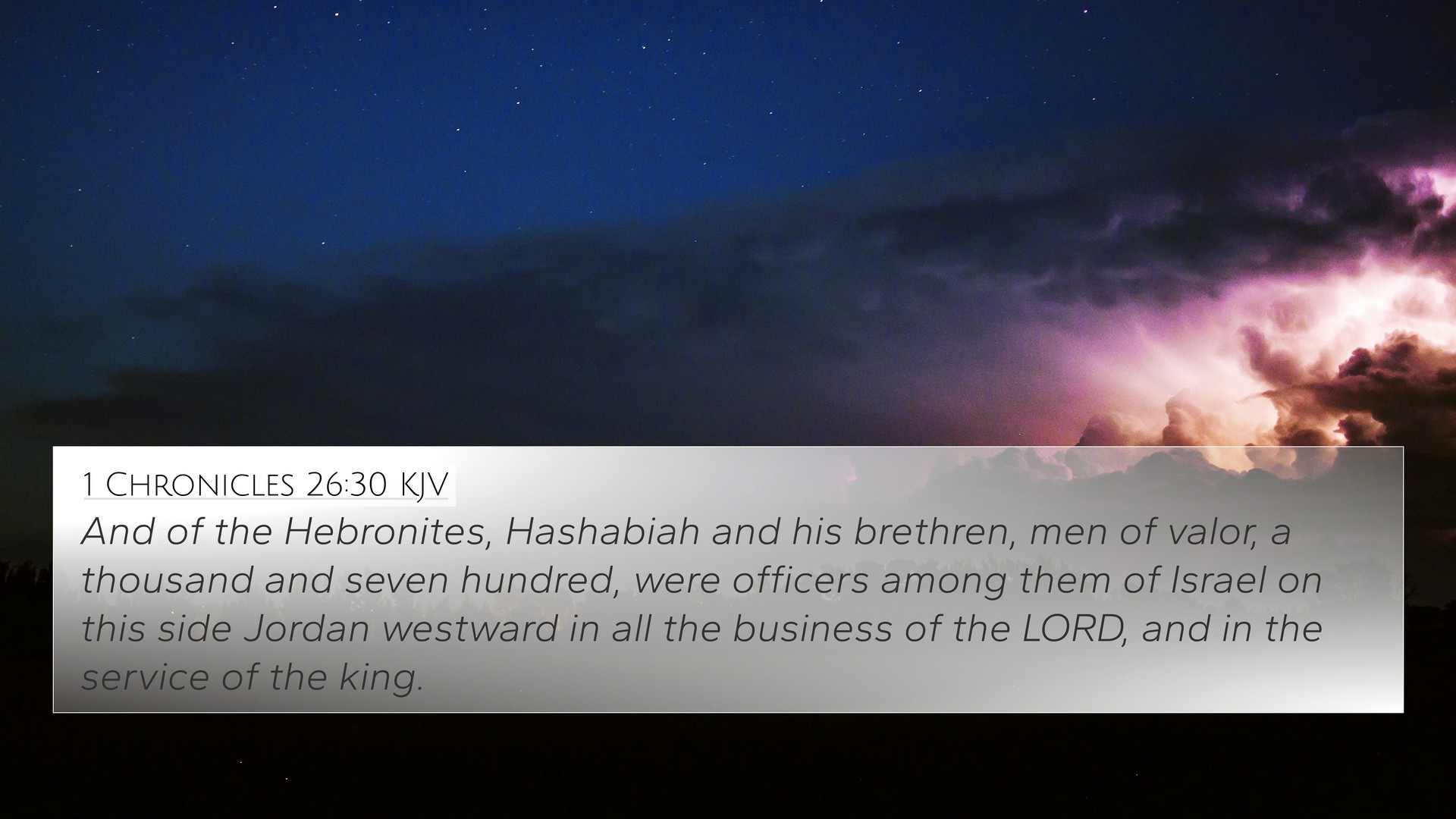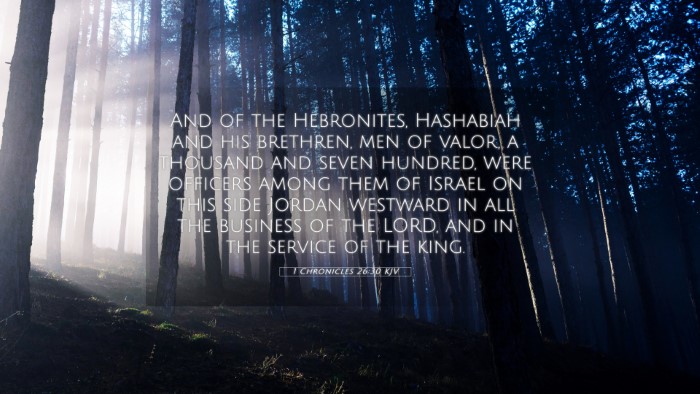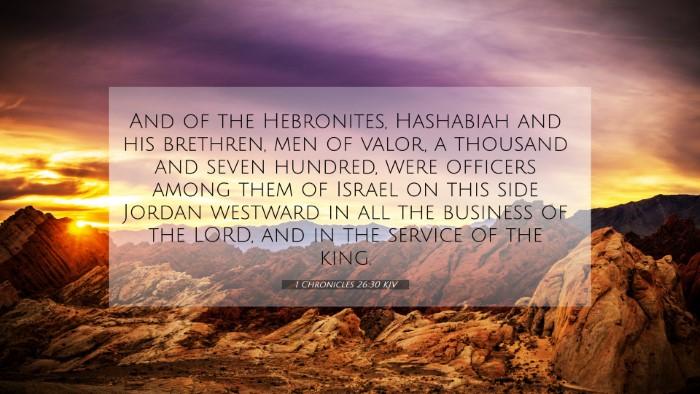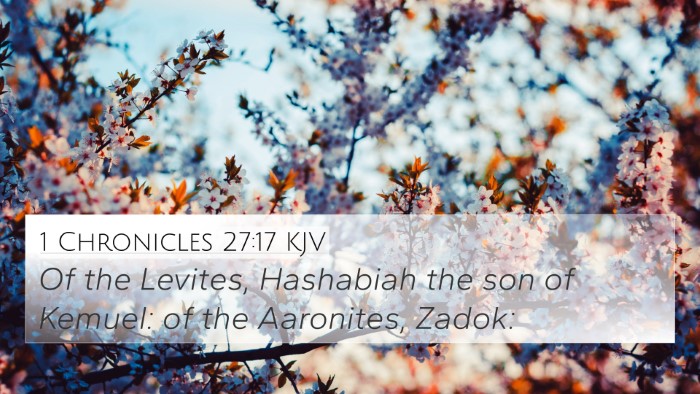Understanding 1 Chronicles 26:30
1 Chronicles 26:30 reads: "Of the Hebronites, Jerijah was the chief; even among the Hebronites, according to his genealogy by his fathers." This verse pertains to the organization of the Levites and highlights the leadership role of Jerijah among the Hebronites.
Contextual Overview
In 1 Chronicles, a significant portion of the text is dedicated to establishing genealogies, particularly related to the Levites and their roles within the Israelite community. This particular verse situates Jerijah as a prominent figure amidst the Hebronite clan, emphasizing the importance of ancestral lineage and authority.
Insights from Public Domain Commentaries
-
Matthew Henry:
Henry emphasizes the importance of order and structure within the priestly systems, suggesting that Jerijah's leadership is pivotal in maintaining these ecclesiastical roles. His commentary underlines that leadership within the church is rooted in God's chosen lineage.
-
Albert Barnes:
Barnes focuses on the significance of genealogical records in keeping historical and spiritual accuracy, indicating that Jerijah’s mention is a confirmation of God’s covenant with the Levites. This reflects the larger theme of heritage and divine appointment.
-
Adam Clarke:
Clarke provides a detailed interpretation of the Hebronites, noting their historical alliances and roles. He correlates Jerijah's leadership with the need for strong guidance and moral authority in the community, linking it to the broader narrative of the Israelites’ journey.
Theological Significance
This verse not only acknowledges Jerijah's place in genealogical records but also highlights the overarching theme of God's chosen leaders throughout biblical history. The lineage of Levites and their appointed leaders is crucial, as it connects to the themes of divine order, leadership, and accountability in worship practices.
Bible Cross-References
To understand how 1 Chronicles 26:30 connects to other scripture, consider the following cross-references that build a thematic understanding of leadership and genealogy:
- Exodus 6:18-25: Lists the lineage of the Levites, providing context for Jerijah's heritage.
- 1 Chronicles 23:14: Discusses the Levites' responsibilities and their roles in worship, complementing the hierarchical structure presented in 1 Chronicles 26.
- Numbers 3:27-29: Offers details on the families of the Levites, emphasizing their priestly duties and their place in Israelite society.
- Hebrews 7:14: Relates to Jesus’ lineage and His priesthood, demonstrating an eternal priestly order connected with earthly genealogies.
- 2 Samuel 21:8: References the descendants of Saul, linking genealogies and the impact of leadership from different tribes on Israel's history.
- Luke 3:34-38: Provides a New Testament genealogy that connects back to the Old Testament, enhancing the understanding of legacy and continuity.
- Ezekiel 44:15: Speaks of the Levitical priests and their duties, which ties into the greater narrative of priestly service throughout Scripture.
Connecting Themes
The verse serves as a reminder of the significance of heritage in God's plan. It reflects the broader biblical narrative that emphasizes connection, continuity, and the fulfillment of God's promises through specific lineages. This connects to the New Testament's emphasis on the fulfillment of the law and the prophetic scriptures through Jesus Christ.
Tools for Bible Cross-Referencing
For those studying these connections further, consider using:
- Bible Concordance: A tool that helps locate specific words and their occurrences throughout the Bible.
- Bible Cross-Reference Guide: A compilation of verses that are related, which can help in deeper studies.
- Bible Reference Resources: Various materials that assist in linking related scriptures effectively.
- Bible Chain References: A method of linking scriptures that elucidate a common theme or concept.
Conclusion
Understanding 1 Chronicles 26:30 requires looking at its genealogical significance, its role within the Israelite leadership structure, and its thematic connections to the ongoing narrative of Scripture. By recognizing the intricate links and cross-references through scripture, Christians gain a richer understanding of God's plan and the importance of spiritual heritage.





